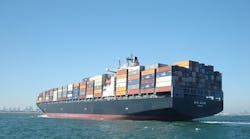After a year of fluctuations driven by the uncertainty of the trade war with China, volume at the nation’s major retail container ports is expected to return to its usual seasonal patterns during the first few months of 2020, according to the Global Port Tracker report released on Jan. 10 by the National Retail Federation and Hackett Associates.
“We’ll be more confident after we see the Phase One agreement signed, but right now 2020 looks like it should be back to what used to be normal,” NRF vice president for Supply Chain and Customs Policy Jonathan Gold said
. “We’ve been through a cycle of imports surging ahead of expected tariff increases – some of which got delayed, reduced or canceled – and falling off again afterward. That’s not good for retailers trying to manage their inventory levels or trying to make long-term business plans. And tariffs are never good for consumers, businesses or the economy.”
“It is not surprising that even the Federal Reserve suggests that the impact of the trade war has a negative impact on the U.S. economy,” Hackett Associates Founder Ben Hackett said, citing recent government data on declines in industrial production and increases in inventory-to-sales ratios. “This combination of reduced output counterbalanced by increased inventory underlies the uncertainties of the tariff wars.”
President Trump is scheduled to sign a “Phase One” partial trade deal with China on Jan. 15y. In announcing the deal, the administration said it would lower tariffs that took effect in September and canceled another round that was set to take effect December 15, but others remain in effect.
U.S. ports covered by Global Port Tracker handled 1.67 million Twenty-Foot Equivalent Units in November, the latest month for which after-the-fact numbers are available. That was down 11.2 % from October and down 7.5% year-over-year.
With on-again, off-again progress on trade negotiations reported throughout the fall and other factors affecting shipping, an expected surge ahead of the canceled December tariff increase did not materialize. December was estimated at 1.7 million TEU, down 13.4% from unusually high numbers seen in December 2018, when retailers had frontloaded imports ahead of a scheduled January 1, 2019, tariff increase that was ultimately postponed
While numbers for the full year are not yet final, estimates indicate that 2019 came in at 21.6 million TEU, a 0.9% decrease from 2018 but still the second-highest year on record. Imports during 2018 hit a record 21.8 million TEU, partly due to frontloading ahead of anticipated 2019 tariffs.
January is forecast at 1.8 million TEU, down 5% from January 2019. February is forecast to be down 4.9% year-over-year at 1.54 million TEU but March is expected to be up 5.2 percent at 1.7 million TEU, with both swings tied to fluctuations in the Lunar New Year calendar and related factory shutdowns in Asia. April is forecast at 1.78 million TEU, up 2.1% year-over-year, and May is forecast at 1.87 million TEU as summer merchandise arrives, up 1% year-over-year.



